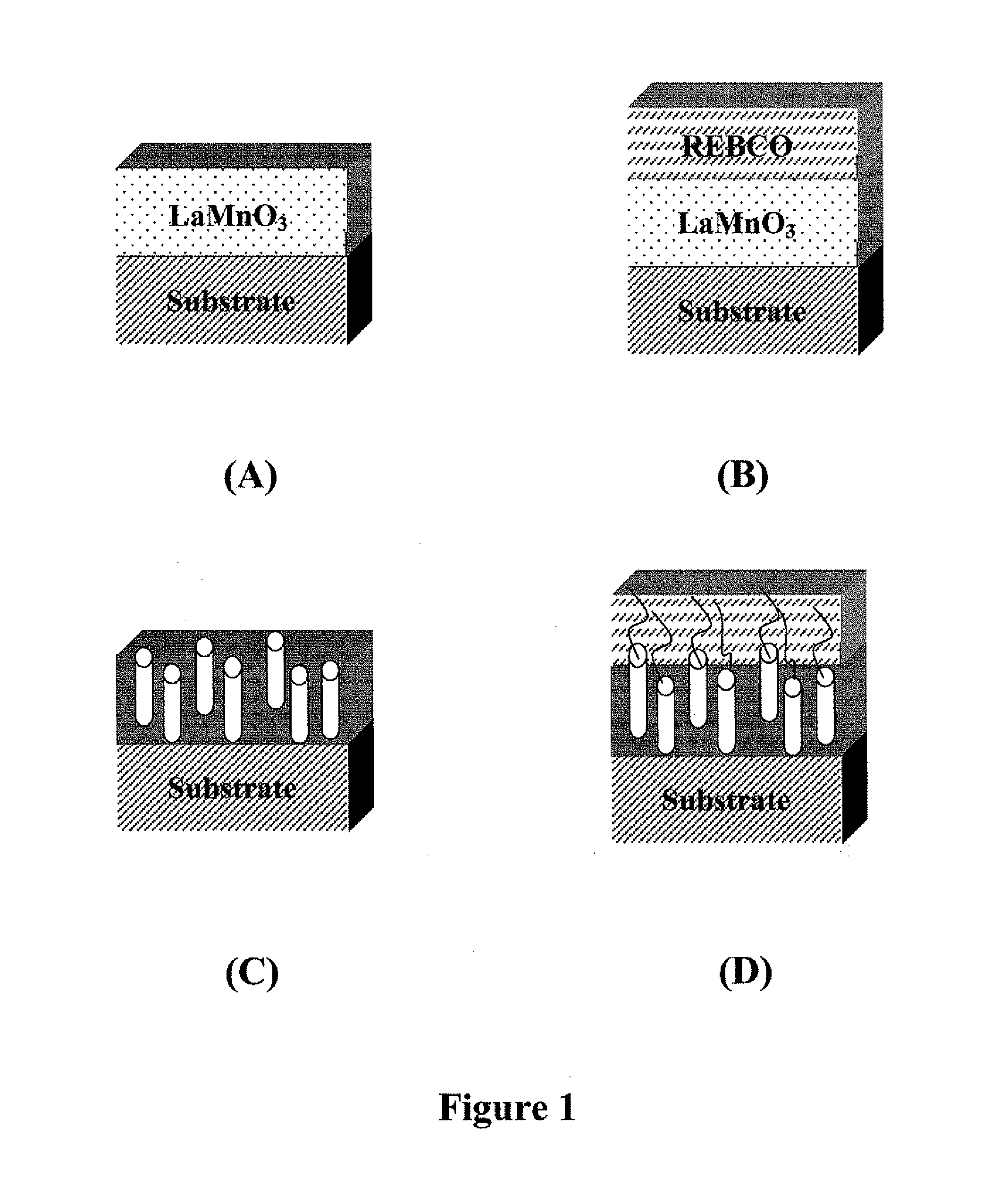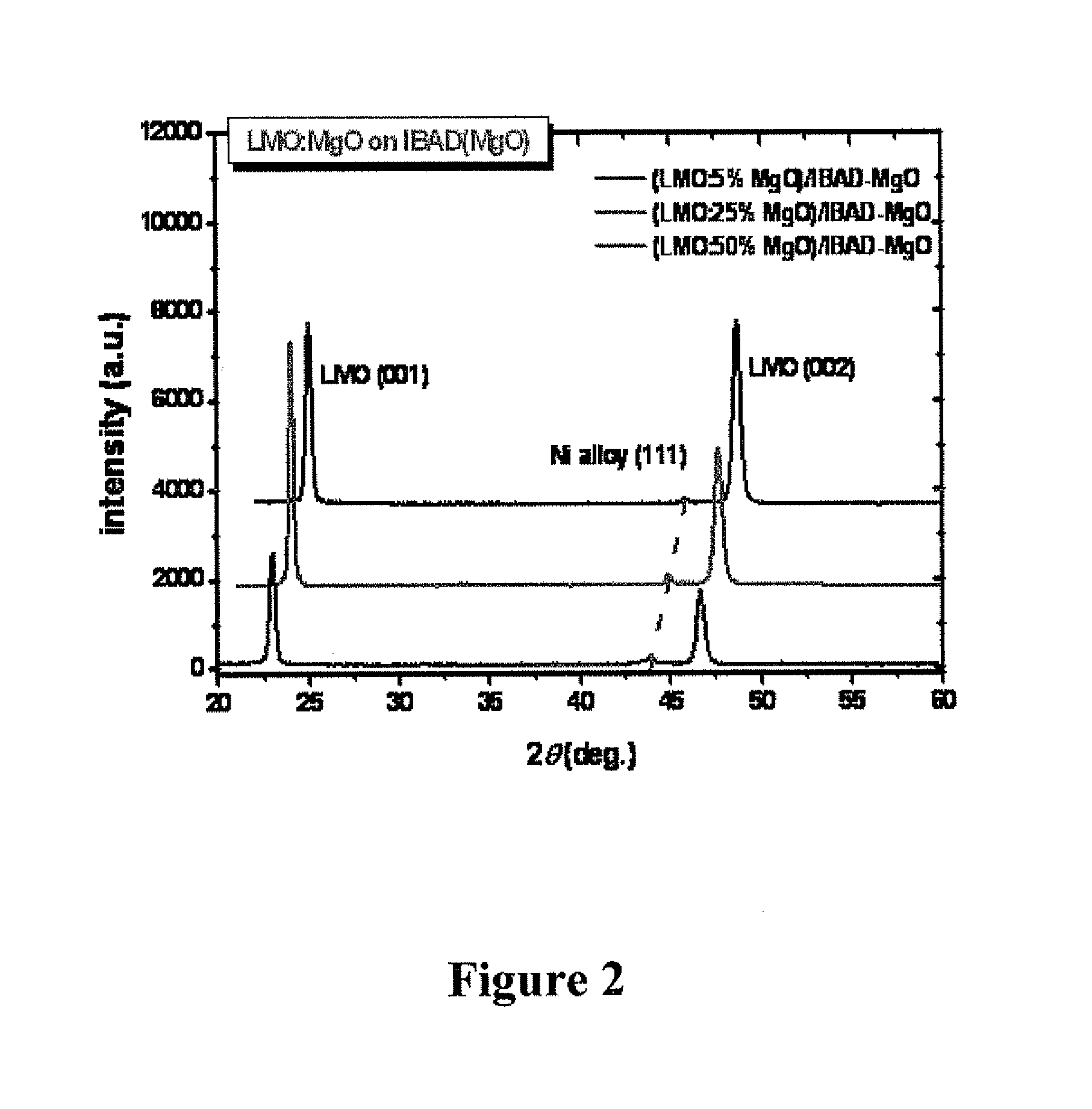Method for producing microstructured templates and their use in providing pinning enhancements in superconducting films deposited thereon
a microstructured template and enhancement technology, applied in the direction of superconductor films, vacuum evaporation coatings, superconductor devices, etc., can solve the problems of superconductor films, unacceptably low critical current densities of hts tapes, and dispersion of critical current density, so as to increase flux pinning and reduce ac losses. , the effect of industrial efficiency and financial feasibility
- Summary
- Abstract
- Description
- Claims
- Application Information
AI Technical Summary
Benefits of technology
Problems solved by technology
Method used
Image
Examples
example 1
The Substrates
[0126]RF magnetron sputtering was employed to deposit phase-separated layers on two types of substrates referred to herein as “IBAD-MgO” and “Homo-epi-MgO / IBAD-MgO” substrates or templates. The substrate referred to as “IBAD-MgO” refers to the IBAD-MgO / Y2O3 / Al2O3 / Ni-based alloy substrate as generally depicted in FIG. 10B. The substrate referred to as “Homo-epi-MgO / IBAD-MgO” refers to the Homo-epi-MgO / IBAD-MgO / Y2O3 / Al2O3 / Ni-based alloy substrate as generally depicted in FIG. 1A. The substrates used in this study were fabricated according to the method described in X. M. Xiong, et al., “High Throughput Processing of Long-length IBAD MgO and Epi-buffer Templates at SuperPower”, IEEE Trans. Appl. Supercond., 17, 3375 (2007).
IBAD-MgO Substrate
[0127]The first layer is an 80 nm-thick Al2O3 layer that serves as a barrier for upward diffusion of substrate cations. The superior diffusion barrier properties of Al2O3 for transition metals such as Ni, Cr, Mn, Mo, etc., as well as f...
example 2
Deposition of a Phase-Separated LMO:MgO Layer on IBAD-MgO and Homo-Epi-MgO / IBAD-MgO Substrates
In-Situ Annealing of Substrate Prior to Deposition of LMO:MgO Phase-Separated Layer
[0129]As the MgO surface is known to be hygroscopic, an annealing process was performed on the substrate of the MgO surface prior to deposition of the phase-separated layer. The annealing process was conducted in a manner that removes surface-adsorbed water and hydrocarbons. Removal of these species ensures a chemically clean surface for the reproducible growth of subsequent LMO:MgO composite layers. The annealing process included the following steps:
[0130]1. The annealing gas, in this case, a mixture of Ar, H2 (4%) and O2 (or alternatively, a mixture of Ar, H2 (4%) and water vapor) was introduced into the deposition chamber, and the total chamber pressure adjusted to 5×10−3 Torr.
[0131]2. The temperature of the substrates was increased from room temperature (RT) to 720° C. at a rate of 140° C. / min.
[0132]3. T...
example 3
Analysis of the Phase-Separated Layers in the LMO:MgO-Coated Substrates
X-Ray Diffraction Measurements
[0149]FIG. 2 shows a series of X-ray θ-2θ scans for LMO:MgO composite films, prepared above at varying MgO concentrations of 5 vol %, 25 vol %, and 50 vol %, deposited directly on IBAD-MgO templates. As shown, for all compositions, the films have a preferred c-axis orientation. Due to the absence of a homo-epi layer (the bottom scan) it is difficult to distinguish the MgO peak reflection at this level of display.
[0150]FIG. 3 shows the surface morphology of the composite LMO:MgO (25 vol %) film deposited on homo-epi-MgO / IBAD-MgO template (as prepared above) as obtained by an AFM scan. As shown, the AFM scan shows the presence of a high density of bright features. Significantly, a scanning Auger microprobe analysis of these features confirmed that these features are Mg-rich regions, and this evidences two-dimensional projections of phase-separated, vertically-ord...
PUM
| Property | Measurement | Unit |
|---|---|---|
| Temperature | aaaaa | aaaaa |
| Composition | aaaaa | aaaaa |
| Superconductivity | aaaaa | aaaaa |
Abstract
Description
Claims
Application Information
 Login to View More
Login to View More - R&D
- Intellectual Property
- Life Sciences
- Materials
- Tech Scout
- Unparalleled Data Quality
- Higher Quality Content
- 60% Fewer Hallucinations
Browse by: Latest US Patents, China's latest patents, Technical Efficacy Thesaurus, Application Domain, Technology Topic, Popular Technical Reports.
© 2025 PatSnap. All rights reserved.Legal|Privacy policy|Modern Slavery Act Transparency Statement|Sitemap|About US| Contact US: help@patsnap.com



